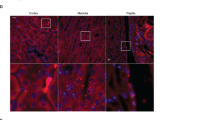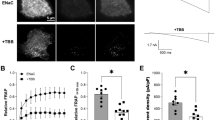Abstract
A key question in systems biology is how diverse physiologic processes are integrated to produce global homeostasis1. Genetic analysis can contribute by identifying genes that perturb this integration. One system orchestrates renal NaCl and K+ flux to achieve homeostasis of blood pressure and serum K+ concentration (refs. 2,3). Positional cloning implicated the serine-threonine kinase WNK4 in this process4; clustered mutations in PRKWNK4, encoding WNK4, cause hypertension and hyperkalemia (pseudohypoaldosteronism type II, PHAII5) by altering renal NaCl and K+ handling. Wild-type WNK4 inhibits the renal Na-Cl cotransporter (NCCT); mutations that cause PHAII relieve this inhibition6. This explains the hypertension of PHAII but does not account for the hyperkalemia. By expression in Xenopus laevis oocytes, we show that WNK4 also inhibits the renal K+ channel ROMK. This inhibition is independent of WNK4 kinase activity and is mediated by clathrin-dependent endocytosis of ROMK, mechanisms distinct from those that characterize WNK4 inhibition of NCCT. Most notably, the same mutations in PRKWNK4 that relieve NCCT inhibition markedly increase inhibition of ROMK. These findings establish WNK4 as a multifunctional regulator of diverse ion transporters; moreover, they explain the pathophysiology of PHAII. They also identify WNK4 as a molecular switch that can vary the balance between NaCl reabsorption and K+ secretion to maintain integrated homeostasis.
This is a preview of subscription content, access via your institution
Access options
Subscribe to this journal
Receive 12 print issues and online access
$209.00 per year
only $17.42 per issue
Buy this article
- Purchase on Springer Link
- Instant access to full article PDF
Prices may be subject to local taxes which are calculated during checkout





Similar content being viewed by others
References
Ideker, T. et al. Integrated genomic and proteomic analyses of a systematically perturbed metabolic network. Science 292, 929–934 (2001).
Lifton, R.P., Gharavi, A.G. & Geller, D.S. Molecular mechanisms of human hypertension. Cell 104, 545–556 (2001).
Giebisch, G. Renal potassium transport: mechanisms and regulation. Am. J. Physiol. 274, F817–F833 (1998).
Wilson, F.H. et al. Human hypertension caused by mutations in WNK kinases. Science 293, 1107–1112 (2001).
Gordon, R.D. Syndrome of hypertension and hyperkalemia with normal glomerular filtration rate. Hypertension 8, 93–102 (1986).
Wilson, F.H. et al. Molecular pathogenesis of inherited hypertension with hyperkalemia: the Na-Cl cotransporter is inhibited by wild-type but not mutant WNK4. Proc. Natl. Acad. Sci. USA 100, 680–684 (2003).
Reeves, W.B. & Andreoli, T.E. Sodium chloride transport in the loop of Henle, distal convoluted tubule, and collecting duct. in The Kidney: Physiology and Pathophysiology. 3rd. edn. (eds. Seldin, D.W. & Giebisch, G.) 1333–1369 (Lippincott Williams and Wilkins, Philadelphia, Pennsylvania, 2000).
Verrey, F., Hummler, E., Schild, L. & Rossier, B.C. Control of Na+ transport by aldosterone. in The Kidney: Physiology and Pathophysiology. 3rd. edn. (eds. Seldin, D.W. & Giebisch, G.) 1441–1471 (Lippincott Williams and Wilkins, Philadelphia, Pennsylvania, 2000).
Xu, B. et al. WNK1, a novel mammalian serine/threonine protein kinase lacking the catalytic lysine in subdomain II. J. Biol. Chem. 275, 16795–16801 (2000).
Zeng, W. et al. Evidence for endocytosis of ROMK potassium channel via clathrin-coated vesicles. Am. J. Physiol. Renal Physiol. 283, F630–F639 (2002).
Mellman, I. Endocytosis and molecular sorting. Annu. Rev. Cell Dev. Biol. 12, 575–625 (1996).
van der Bliek, A.M. et al. Mutations in human dynamin block an intermediate stage in coated vesicle formation. J. Cell Biol. 122, 553–563 (1993).
Slepnev, V.I., Ochoa, G., Butler, M.H. & de Camilli, P. Tandem arrangement of the clathrin and AP-2 binding domains in amphiphysin 1 and disruption of clathrin coat function by amphiphysin fragments comprising these sites. J. Biol. Chem. 275, 17583–17589 (2000).
Chen, J., Fujii, K., Zhang, L., Roberts, T. & Fu, H. Raf-1 promotes cell survival by antagonizing apoptosis signal-regulating kinase 1 through a MEK-ERK independent mechanism. Proc. Natl. Acad. Sci. USA 98, 7783–7788 (2001).
Charette, S.J., Lambert, H. & Landry, J. A kinase-independent function of Ask1 in caspase-independent cell death. J. Biol. Chem. 276, 36071–36074 (2001).
Choate, K.A., Kahle, K.T., Wilson, F.H., Nelson-Williams, C. & Lifton, R.P. WNK1, a kinase mutated in inherited hypertension with hyperkalemia, localizes to diverse Cl—transporting epithelia. Proc. Natl. Acad. Sci. USA 100, 663–668 (2003).
Boim, M.A. et al. ROMK inwardly rectifying ATP-sensitive K+ channel. II. Cloning and distribution of alternative forms. Am. J. Physiol. 268, F1132–F1140 (1995).
Ho, K. et al. Cloning and expression of an inwardly rectifying ATP-regulated potassium channel. Nature 362, 31–38 (1993).
Gamba, G. et al. Primary structure and functional expression of a cDNA encoding the thiazide-sensitive, electroneutral sodium-chloride cotransporter. Proc. Natl. Acad. Sci. USA 90, 2749–2753 (1993).
Leipziger, J. et al. PKA site mutations of ROMK2 channels shift the pH dependence to more alkaline values. Am. J. Physiol. Renal Physiol. 279, F919–F926 (2000).
Ortega, B., Millar, I.D., Beesley, A.H., Robson, L. & White, S.J. Stable, polarised, functional expression of Kir1.1b channel protein in Madin-Darby canine kidney cell line. J. Physiol. 528, 5–13 (2000).
Acknowledgements
We thank I. Giménez, P. Zhang and members of the laboratory of W. Boron for harvest of X. laevis oocytes, and P.Z. Svigals for technical assistance. This work was supported by a Specialized Center of Research Grant in Hypertension (R.P.L.) and an Interactive Program Grant (S.C.H.) from the US National Institutes of Health. K.T.K. is recipient of a Howard Hughes Medical Institute Medical Student Research Fellowship. M.D.L. is a recipient of a Human Frontiers Long Term Fellowship. R.P.L. is an Investigator of the Howard Hughes Medical Institute.
Author information
Authors and Affiliations
Corresponding author
Ethics declarations
Competing interests
The authors declare no competing financial interests.
Rights and permissions
About this article
Cite this article
Kahle, K., Wilson, F., Leng, Q. et al. WNK4 regulates the balance between renal NaCl reabsorption and K+ secretion. Nat Genet 35, 372–376 (2003). https://doi.org/10.1038/ng1271
Received:
Accepted:
Published:
Issue Date:
DOI: https://doi.org/10.1038/ng1271
This article is cited by
-
Regulation of distal tubule sodium transport: mechanisms and roles in homeostasis and pathophysiology
Pflügers Archiv - European Journal of Physiology (2022)
-
WNK-SPAK/OSR1-NCC kinase signaling pathway as a novel target for the treatment of salt-sensitive hypertension
Acta Pharmacologica Sinica (2021)
-
Transcriptomic profiles of Dunaliella salina in response to hypersaline stress
BMC Genomics (2020)
-
Cullin-3: Renal and Vascular Mechanisms Regulating Blood Pressure
Current Hypertension Reports (2020)
-
Genome-wide meta-analysis of variant-by-diuretic interactions as modulators of lipid traits in persons of European and African ancestry
The Pharmacogenomics Journal (2020)



